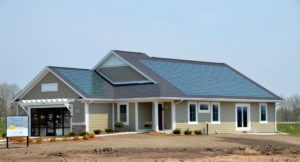
What is a net zero home? The term “net zero” or “net zero energy” refers to a building (such as a home) that uses no more energy than it produces. Through a combination of high efficiency and home green energy production, a net zero home generates no electric or other energy bills. It burns no fossil fuels. It depletes no global energy resources. It is self-sufficient in terms of energy, either literally and completely or at least mathematically (so that the amount of energy it produces equals or exceeds the amount used, even if some of the energy used does actually come from elsewhere).
The U.S. federal government and a number of state governments, notably California, have developed prototypes of net zero homes. The prototype homes incorporate information technology along with the latest in energy-efficiency design to get maximum use out of every erg of power. They key to sustainability isn’t doing without, but doing more with: not using less energy but wasting less energy. Energy that is thrown away by inefficient design does us no good but still exerts a drain on natural resources. In addition to high efficiency design, net zero homes also incorporate methods to produce energy for the home’s use. Between the two, the home draws a net of zero energy from the environment.
Energy Efficiency
The first part of the design of a net zero home is to make it super-efficient in terms of energy. This goes far beyond adequate insulation. A net zero home employs passive lighting and heating to maximize natural illumination and warmth and minimize the need for artificial lighting and heat. Computer controlled appliances darken rooms automatically when they are not in use and direct warm or cool air where it is needed most. Modern designs maximize the efficiency of furnaces, water heaters, lighting fixtures, and appliances. These design features alone would reduce the energy consumption of a home to very low levels while still maintaining high levels of comfort and convenience. (A net zero home involves nothing in the way of “belt tightening.” The idea, once again, is not to use less energy but to waste less energy.)
Home Energy Production
No matter how efficient a home becomes, the energy requirements can never be brought down to zero. It will always be necessary to light the home, heat it, cook food, heat water, and provide electricity for computing and entertainment. This is why the concept is not one of zero energy but of net zero energy, in which the energy used is subtracted from the energy produced, leaving a result of zero.
A net zero energy home therefore needs to incorporate energy production using one or more methods of renewable energy. This is likely to include either solar panels or wind turbines or both. The cost and efficiency of both solar and wind energy have been improving dramatically in recent years and are expected to go on doing so for a while. They are already less expensive than most conventional forms of energy and should become cheaper than natural gas within a few more years.
Combined with the high efficiency design of a net-zero home, a relatively small production capacity for home-generated renewable energy can produce enough electricity to completely power the home. If the home is connected to the grid, the home energy system doesn’t need to produce all of the power the home needs at any given moment. Once again, the concept of net zero energy is important here. The home may at times draw on commercially-produced energy, but if the amount of power it draws is subtracted from the amount it produces, the result should be zero or less.
Net Zero Homes Already In Production
While some of the technology to be incorporated into the most advanced net zero home designs is experimental and new, in fact net zero homes have been constructed since the 1990s. There are a number of construction companies actively building and marketing net zero homes. Current designs, however, are inefficient compared to what is likely to be available before long. That makes them more expensive, in that they require larger and more powerful home energy production systems due to some energy being wasted that could potentially be saved.
Currently, the cost-saving features of a net zero home add about $5,000 to the price of the home, not including the cost of the renewable energy production system. Despite this, there is a considerable market for the homes, driven partly by a desire to reduce energy costs and partly by environmental consciousness. As the technology matures, however, it’s expected that the homes will become “net zero” in price, as well, with energy savings more than offsetting any increase in the cost of the home. Eventually, net zero homes should be expected to
become the building standard, and all new homes will be net zero thereafter. It’s an important part of our transition to an environmentally sustainable society.

